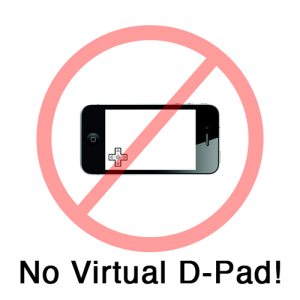NO VIRTUAL D-PAD. This was the phrase that rattled around in my brain as we began designing our new game. Lots of iPhone games make use of this dreaded control scheme and I've yet to see it work well in any game. From Street Fighter IV to FIFA, developers freaking LOVE the virtual d-pad. Even more frustrating is the fact that many games, such as the two series I mentioned before, have solid core gameplay systems but are ruined by this strange design decision.
Some game designs simply aren't meant for the iPhone. The iPhone has a touch screen, not a gamepad (surprise!), so games requiring lots of tactile feedback just don't work on the device. 97 hit combos, strafing head shots, and precise platforming are several gameplay mechanics that, when paired with a virtual d-pad, can become an iPhone chucking frustration.
Other games, such as Mirror's Edge on the iPhone, treat the device as a new, exciting way to create a similar gameplay experience to their console brethren, without the need to emulate it 100 percent. EA's game uses a clever swiping control screen that proves a really satisfying way to move the character around. By making use of an input method that iPhone users already understand, the game's control scheme feels totally natural. Winning!
As we began assembling our iPhone game, Texel and I were determined to avoid the virtual d-pad. So far our "no d-pad" mentality has worked out very well. The user simply taps where the character should move, double taps for attacks/interactions, and has use of two HUD buttons for inventory/saving/options. Simplicity. It's why we all bought an iPhone in the first place.

